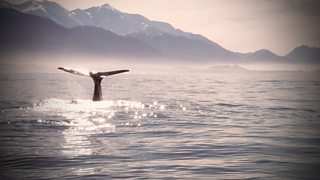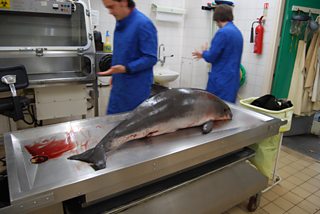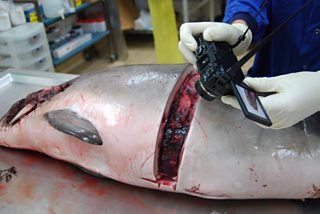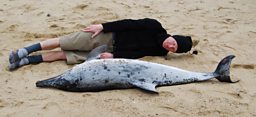Seriously Reads: CSI Whale
Up to 600 whales, dolphins and porpoises become stranded on Britain’s beaches and coastlines every year. In a new documentary, the award-winning author and self-confessed ‘whalehead’ Philip Hoare investigates why it happens and what the stranded animals’ bodies can teach us...
Having spent 15 years working - often intimately - on the subject of cetaceans (whales, dolphins and porpoises), I welcomed an invitation from Tim Dee, the radio producer, to work on the documentary CSI Whale.

A whale or dolphin on a beach is where it should not be. It seems to be paying for its sins, for its hubris in having forsaken the land - to which we earthly beings are bound."
The notion of a cetacean on land tugs deeply on our sensibilities. A whale or dolphin on a beach is where it should not be. It seems to be paying for its sins, for its hubris in having forsaken the land - to which we earthly beings are bound. It is as if it is being punished for thinking that it could escape. A whale, in particular, suffers physically because of its physicality. Stranded whales suffocate themselves, under the weight of their own bodies - a notion which recalls the chapter in Moby-Dick, in which Melville describes how butchered whales are boiled down in shipboard cauldrons or try-pots whose fires are stoked by slivers of the animal's own flesh: 'Like a plethoric burning martyr, or a self-consuming misanthrope, once ignited, the whale supplies his own fuel and burns by his own body'.
Tim and I followed the work of the wonderfully named Cetacean Strandings Investigation Programme - i.e. CSI Whale - based at the Zoological Society of London's laboratories in Regent's Park. Donning much-bleached white coats, we followed Rob Deaville and Matt Perkins into the dissection room on the ground floor. The large double doors beyond were open to London Zoo outside, with the noises of its animals drifting through the trees. From a huge outdoor freezer, using a big chain winch, Matt hoisted a black bin bag onto the stainless steel mortuary slab.
As he unwrapped it, a large harbour porpoise was revealed. I've often seen these animals, in the waters of Spey Bay in the eastern Highlands of Scotland, or in Cape Cod Bay on the north east coast of the USA. They are cryptic, fleet animals, revealing little of themselves at the surface, rolling through the waves like brown wheels. Yet they were once so common that they were known to fishermen as 'puffing pigs'. In Norman England they were part of the 'Fishes Royal' edict (which preserved stranded cetaceans for the monarch and his circle) and thus exempt from the Christian ban on eating meat on Fridays. Hence the name, from the contraction of porc poisson - pork fish.
Over the next two hours, Rob and Matt took the animal apart. Resisting my initial nausea - Rob says he doesn't notice the smell nowadays, "Although I always get a seat on the train home" - I realised that the process actually extended my admiration from the exterior to the interior of these beautiful creatures. Every organ which Rob produced was almost exactly like mine. It was if I was being dissected on that steel slab.

In the course of my work - researching my two books on the subject, Leviathan or, The Whale (2008) and The Sea Inside (2013) - I've often come into contact with dead as well as living whales and dolphins. When making The Hunt for Moby-Dick, a documentary for the BBC's Arena strand, myself, director Adam Low and producer Martin Rosenbaum filmed a dead minke whale on a wintry beach outside Skegness. You could smell the carcass from a mile away. The stink stayed in my nostrils, and on my clothes, for days.
Yet the sight of the cetacean, slowly rotting into the North Sea sand, was somehow plangent - reminiscent of the stranded whales on the coast of The Netherlands, famous from 17th Century depictions in paintings and even on Delftware. Then, such beachings were regarded as omens - either of evil or of good fortune, depending on what suited the political or meteorological climate.
These days, thanks to the work of the CSIP team, we know a little more about why whales and dolphins strand. Up to 600 animals are found on UK coasts each year - the majority are smaller cetaceans, such as dolphins and porpoises. Mass strandings, such as that of a group of pilot whales at Staffin on Skye, usually involve toothed whales (dolphins, porpoises, so-called 'blackfish', and sperm whales) which are inordinately social animals and will follow ailing comrades into shallow waters and even onto land.

Beachings were once regarded as omens - either of evil or of good fortune, depending on what suited the political or meteorological climate"
Reasons cited include bad weather, which may disrupt their navigational abilities, and anomalies in the electromagnetic paths which cetaceans use, like birds, during migration. But modern strandings have been blamed on military sonar exercises, and the use of seismic surveys in oil exploration - the latter an ironic possibility, given that many cetacean species were exploited for their own oil.
Increasingly, blame is also laid on pollutants in the ocean. PCBs from pesticides, fire retardants, heavy metals such as lead, mercury and chromium, all enter cetacean bodies by virtue of their place at the top of the marine food chain. The accumulation of these toxins causes the animals' immune systems to become comprised. Sometimes, all these elements collide, drastically.
In December 2009, seven sperm whales stranded on a southern Italian beach. They had been driven into shallow waters, possibly by naval sonar exercises. Whales gain their fresh water from the food they eat, and as sperm whales feed at great depth on squid, these whales were not only starving, but dehydrating.
As a result, the adipose fat in their bodies began to break down, releasing the toxins stored therein. The whales were poisoning themselves. With this further compromise to their immune systems, they became disorientated. Bad weather then set in, with storms driving the animals on shore.
The last straw in their drama was revealed by the necropsies of the whales' bodies. Scientists discovered their stomachs to be filled with fishing gear, hooks, rope and plastic objects. In the scientific paper which documented the incident, the co-authors seemed moved to transgress over notions of objectivity, describing, in controlled but emotional terms, the whales that they found 'agonising on the shore'.
Yet these incidents at least give scientists vital data which may assist efforts to prevent such occurrences. As Rob Deaville notes, the apparent increase in strandings may be a result, paradoxically, of good news. In some species, whale numbers are recovering from the appalling culls of the 20th Century when, according to a new report from Robert Rocha at the New Bedford Whaling Museum in New England, the factory ships of Britain, Japan, Norway and Russia managed to kill an estimated three million animals. The public are also sensitised to these animals and their plight, and are more likely to report them, or want to help themselves.
I've found the opportunity to get up close to cetaceans a revealing and moving experience. Last year I accompanied a naturalist friend, Dennis Minsky, on a trip to take samples from a common dolphin stranded on the shores of Cape Cod. It was salutary to see this beautiful creature laid out on the sand, only a few yards from passing beach-walkers. It had been there a matter of hours, but already its skin had acquired a dusty bloom, like that on a black plum.
As Dennis took his biopsies, I lay down beside the animal, admiring its exquisitely hydrodynamic dorsal and pectoral fins; the clean sweep of its tail, the resistant yet firmness of its body. The day before, we had seen it with its pod, out at sea, swimming free. A she, in fact, as our intimate investigations proved.

Now she was beached, although, it seemed to me, that some kind of magic might yet send her wriggling back to the water. Dennis's knife, sawing off part of her jaw for scientific analysis, soon put paid to that fantasy. And yet, the challenges that these animals propose - between what they are and what they might be - all this seemed summed up in this one lost, lonely, and lovely cetacean.
Philip Hoare is an author and broadcaster. He has published seven non-fiction books, including The Sea Inside and Leviathan or, The Whale, which won the BBC Samuel Johnson Prize for Non-Fiction in 2009.
More from Seriously...
-
![]()
CSI Whale
Philip Hoare attends the necropsy of a porpoise and thinks about going inside a whale.
-
![]()
Seriously Surprising
Unexpected stories from across the globe.
-
![]()
Another Time, Another Place
Ten years of Antony Gormley's epic installation on Crosby beach.
-
![]()
Seriously...
More quirky, curious, and seriously interesting documentaries.



